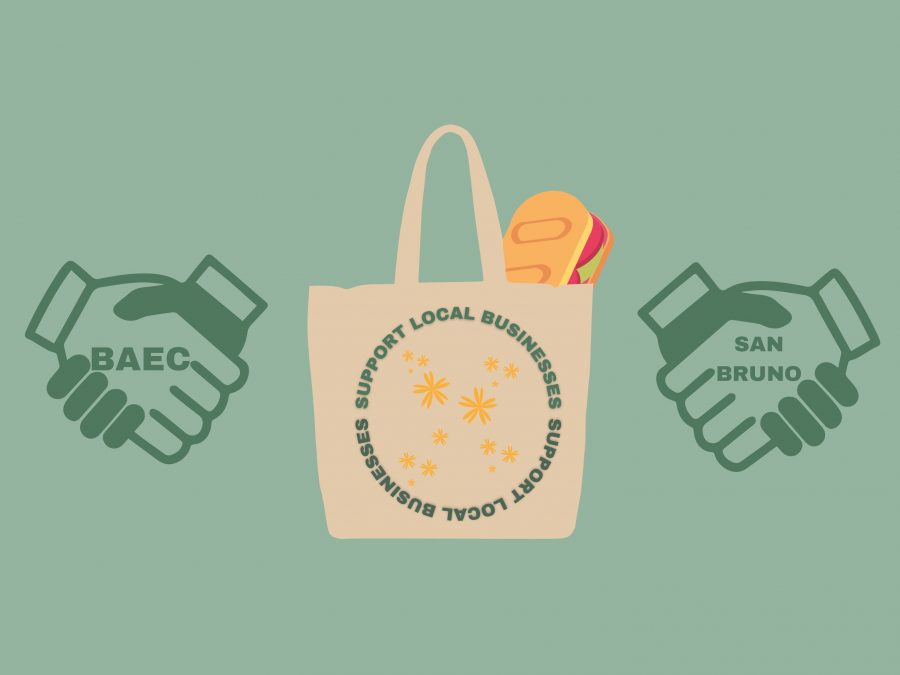The impact of microgrants on San Bruno small businesses
Skyline’s Bay Area Entrepreneurship Center funds a microgrant program to alleviate the impact of COVID-19 on small businesses.
Small businesses dominate the market in SMC, with 97.4 percent of firms operating with less than 100 employees.
Since 1996, Mr. Pickle’s Sandwich Shop has nourished the San Bruno community with fresh ingredients and their signature Boudin bread. But when COVID-19 struck, this staple of the city suffered staggering losses.
“[The pandemic] heavily affected us in every aspect, including the catering business. Our daily sales had gone way down … about 60 percent,” said owner Claudia Lopez. [Not only has there been] shortages on the supplies, but everything — the meats, the vegetables — almost doubled or tripled in price.
This phenomenon is not unique to Mr. Pickle’s. Hundreds of businesses in the Bay Area have been afflicted by supply shortages, rising costs and an overall loss in net income. According to recent data from the U.S. Census Bureau, small businesses dominate the market in San Mateo County, with 97.4 percent of firms operating with less than 100 employees. Unfortunately, such businesses have been hit the hardest by COVID-19.
“Within three weeks of the business closures in the Bay Area, we were 60 percent down … our numbers dropped dramatically,” said Peter Johnson, the owner of martial arts studio Dojo USA. When you’ve been doing something in person for 27 years, how do you instantly change to 100 percent online?”
To address this issue, Skyline’s own Bay Area Entrepreneurship Center (BAEC), with additional support from the San Bruno Community Foundation and the City of San Bruno, issued microgrants to businesses in San Bruno. This initiative is offered as a part of the Small Business Recovery Assistance Program (SBRAP).
“First of all, [these businesses] needed a little cash injection. Many businesses were shifting to online, like restaurants that suddenly had to do online ordering, and some of them didn’t have that capability,” said Michael Kane, the acting director of BAEC. “The other thing that we noticed was some of the businesses needed coaching to help them make changes.”
Over two consecutive years, the grants have piloted such changes for 47 business owners including Lopez and Johnson. 2020 and 2021 recipients were granted $4,000 to $7,000, respectively. After selection by an independent panel, recipients agreed to attend at least six workshops, a major element of the program.
“Some of these workshops include tutorials on creating Canva flyers, [introductions to] different website platforms, how to use Instagram Reels, how to network — all of these basic marketing tools,” said marketing lead Nicole Moreno-Deinzer. “We have guests come on to talk about financial literacy and [ways to apply for] more grants.”
These workshops provide recipients the opportunity to change the landscape of their business, as was the case for Monica Suarez, owner of Balance Health Nutrition.
“I realized that we didn’t have to wait for things to open up again; I can actually continue to do business via Zoom and offer my services that way,” said Suarez. “Just the other day, I was on the coaching call they provided about social media … They provide a lot of great resources on how to use different types of technology.”
With these tools, she now has the bandwidth to extend her services to a wider net of people. While implementing these changes presented challenges, Johnson’s open-minded approach eased his transition process.
“I had to go from being a brick and mortar business to being a click and mortar business,” Johnson said. “Being a business that is all about interpersonal interaction, redefining that over an online platform had its unique challenges … I feel like it’s not the technology that limits us. It’s our psychology. Whether we’re connecting in person or in pixel, connection is connecting.”
The result of Johnson’s forward-thinking mindset, which he hopes to extend to his students, is tangible even for casual passer-byers.
“[The evolution] of Peter’s business was obvious … Before the pandemic, he had a little whiteboard in the window with inspirational messages. Over time, that changed to ‘here’s my website, here’s my Instagram account.’ You could see that evolution just by walking by the storefront,” Kane said.
These improvements have been made possible by the San Bruno Community Foundation, a non-profit funded by the $70 million restitution from the 2010 gas pipeline explosion, $257,000 of which was allocated to the SBRAP.
“At this point, we don’t have plans to continue [the microgrant program], but supporting our small business community, especially as it continues to deal with the economic impact of COVID, is something that we are interested in doing,” said Executive Director Leslie Hatamiya We really appreciate the partnership we developed with the BAEC through this program.”
The San Bruno Community Foundation and BAEC are not the only entities that have formed a partnership. A distinguishing characteristic of the program is its ability to build connections across the participating businesses.
“I’ve noticed that the entrepreneur community is more helpful than competitive. The more I share with other people, the more they show with me as well,” Suarez said. “I’ve really enjoyed growing my business with other entrepreneurs.”
This continued growth and service to the community is at the heart of San Bruno’s small businesses and businesses at large.
“The main reason we wanted to open a business was the American dream. With COVID, the American Dream has been put on hold, but it can still be done,” said Lopez. There’s a lot of resources, like this grant, that are helping small businesses.”









